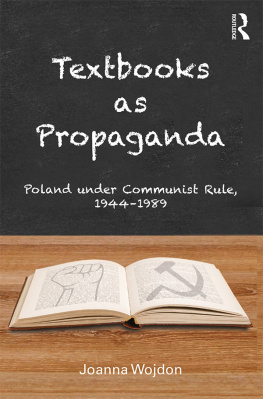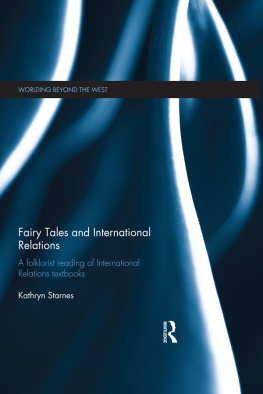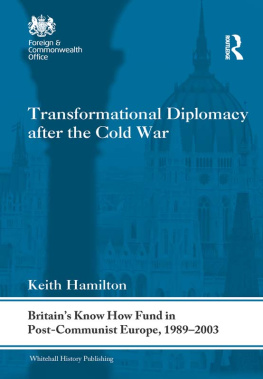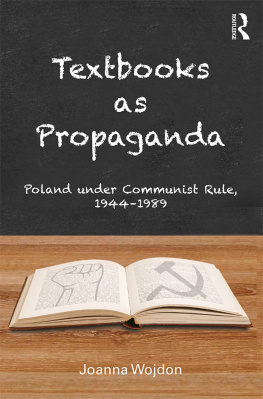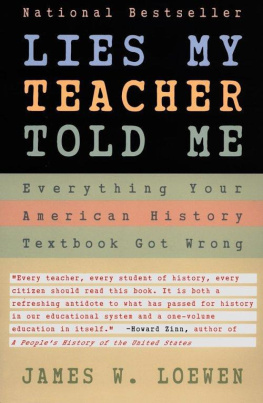Textbooks as Propaganda
Textbooks as Propaganda analyses postSecond World War Polish school textbooks to show that Communist indoctrination started right from the first grade. This indoctrination intensified as students grew older, but its general themes and major ideas were consistent regardless of the age of the readers and the discipline covered.
These textbooks promoted the new, post-war Polands boundaries, its alliance and friendship with the Soviet Union, and communist ideology and its implementation within the countries of the Soviet bloc. Through a thorough analysis of nearly a thousand archival textbooks, Joanna Wojdon explores the ways in which propaganda was incorporated into each school subject, including mathematics, science, physics, chemistry, biology, geography, history, Polish language instruction, foreign language instruction, art education, music, civic education, defense training, physical education and practical technical training. Wojdon also traces the extent of the propaganda, examining its rise and eventual decrease in textbooks as the totalitarian state began its decline.
Positioning school textbooks and textbook propaganda in the broader context of a changing political system, posing questions about the effectiveness of the regimes educational policies and discussing recent research into political influences on school education, this book will appeal to anyone interested in the history of communist-era propaganda.
Joanna Wojdon is an Associate Professor of History at the University of Wrocaw, Poland. Her publications include White and Red Umbrella: Polish American Congress in the Cold War Era (19441988) (2015); The World of Reading Primers: The Image of Reality in the Reading Instruction Textbooks of the Soviet Bloc (in Polish: wiat elementarzy: Obraz rzeczywistoci w podrcznikach do nauki czytania w krajach bloku radzieckiego) (2015); and E-teaching History (2016, ed.). She is the managing editor of the International Journal of Research on History Didactics, History Education and History Culture: Yearbook of the International Society for History Didactics (vol. 3337: 20132016).
Textbooks as Propaganda
Poland under Communist Rule, 19441989
Joanna Wojdon

First published 2018
by Routledge
711 Third Avenue, New York, NY 10017
and by Routledge
2 Park Square, Milton Park, Abingdon, Oxon OX14 4RN
Routledge is an imprint of the Taylor & Francis Group, an informa business
2018 Joanna Wojdon
The right of Joanna Wojdon to be identified as author of this work has been asserted by her in accordance with sections 77 and 78 of the Copyright, Designs and Patents Act 1988.
All rights reserved. No part of this book may be reprinted or reproduced or utilised in any form or by any electronic, mechanical, or other means, now known or hereafter invented, including photocopying and recording, or in any information storage or retrieval system, without permission in writing from the publishers.
Trademark notice: Product or corporate names may be trademarks or registered trademarks, and are used only for identification and explanation without intent to infringe.
First published in Polish in 2000 with the title Propaganda polityczna w podrcznikach dla szk podstawowych Polski Ludowej by the publisher Wydawnictwo Adam Marszalek
Library of Congress Cataloging-in-Publication Data
A catalog record for this book has been requested
ISBN: 978-1-4128-6558-6 (hbk)
ISBN: 978-1-315-11427-9 (ebk)
Typeset in Goudy
by Apex CoVantage, LLC
Contents
The idea of this book originated from my experience as a pupil of the Soviet primary school. We solved hundreds of mathematical exercises about workers producing elements and read countless stories on the Soviet achievements related to all the disciplines of science and all spheres of life. We sang Russian revolutionary songs, and the first poem in English that I learned by heart started with: There is a well-known portrait upon the classroom wall, we see the face of Lenin so dear and loved by all. A few years later, back in Poland and after the collapse of the communist regime, as a young historian, I decided to check to what extent education in the Soviet-dominated Poland followed the Soviet model.
I chose to analyze school textbooks since they play a crucial role as a dominating teaching tool in Poland. They are widely used both at school and for homework. Many teachers and their students follow them step by step. The term doing a textbook was coined to characterize the flow of many lessons. Under communism, some teachers journals openly discouraged teachers from reducing or enhancing the scope of textbook contents and even from changing the order of topics. A textbook was to serve as a universal guide for both teachers and pupils. Such a position adds to its reliability as a historical source documenting school practices of the time. Unlike oral or written testimonies, diaries or copybooks, textbooks are not limited to the individual experiences of one local school, nor do they depend on memory and its distortions and, unlike school curricula, they not only reflect the model of education desirable by the authorities, but also give an idea about everyday school practices. This model was presented in official documents, but textbooks made it more specific. They transformed the general concepts of the curricula into detailed lesson plans: texts, tasks, exercises. Textbooks, not curricula, were what teachers and pupils actually did. Of course, there were exceptions: teachers who taught according to their own beliefs and methods and pupils who used their own sources of knowledge. However, I was interested in the rule, not the exceptions. Textbooks, better than other historical sources, provide an insight into the commonly and universally practiced school routines in Poland under communism. They prove without any doubt that the regime wanted school to indoctrinate the young people already from the first grade.
Another feature of the communist system that made my research more meaningful was the uniformity of all spheres of life imposed by the authorities. Since the late 1940s there was one dominant political party, one youth organization, one school model, and one officially approved textbook for each subject and grade. Thus, all the pupils in Poland learned from exactly the same teaching materials. The analysis of just one set of textbooks tells us what a whole generation studied during their school years and how their minds were shaped.
I chose primary school textbooks for the sake of reconstructing the universal message of the regime addressed to its youngest citizens. Primary education was compulsory for 7- to 14- and later 15-year-olds. Some researchers prefer to focus on secondary schools because their textbook narratives are more sophisticated. However, I was interested not only in the pattern of indoctrination, but also in its possible influence on society. The audience for primary school textbooks was significantly higher. Moreover, younger readers are much less critical and therefore more susceptible to the propaganda messages.
The uniformity of the textbooks made my research easier. The titles of the approved books appeared yearly (or sometimes twice a year) in the official journal of the Ministry of Education. The journal was, thus, the main source of bibliographical data. I took into consideration all the books accepted for general use at schools, but excluded textbooks for children with disabilities and for national minorities. They are interesting per se, but did not play as crucial a role in the shaping the collective memory, identity and imagination. Some textbooks were in use only for one year, others for more than twenty years. Sustainability and changes could be noticed not only by identifying changing authors, titles and official notes, but also by comparing various editions of a given textbook page by page. Altogether, approximately one thousand non-identical volumes of textbooks were singled out. Out of them approximately sixty, mostly from the late 1940s and early 1950s, turned out to be unavailable in the Polish libraries. Still, 94% formed a sufficient basis from which to draw conclusions.

